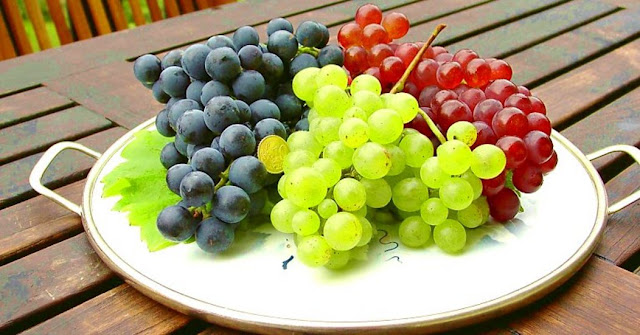Exploring the World of Grapes: Types and Varieties You Should Know
Grapes are one of the most versatile and delicious fruits out there. Whether you're snacking on them fresh, savoring a glass of wine, or using them in a salad, grapes bring a burst of flavor that’s hard to beat. But did you know that there are many different types of grapes, each with its own unique taste and texture? In this blog, we’ll take a closer look at the major types of grapes and what makes them so special.
1. Table Grapes
These are the ones you typically find in grocery stores and enjoy fresh as a snack. Table grapes are sweet, juicy, and crunchy, making them a perfect addition to a fruit salad or enjoyed on their own. They come in several varieties, but here are some of the most popular ones:
Thompson Seedless: This is one of the most common varieties of table grapes, known for its pale green color and sweet, juicy flesh. Thompson Seedless grapes are often used for raisins as well, but they’re also excellent for eating fresh.
Red Globe: These grapes are large, round, and deep red in color. They’re incredibly sweet and have a slightly thicker skin, making them a great choice for snacking or adding to fruit platters.
Autumn Royal: If you love black grapes, then Autumn Royals are a must-try. These grapes have a deep purple to almost black color and are known for their bold, sweet flavor and firm texture.
2. Wine Grapes
Wine grapes are the heart and soul of winemaking. They tend to have higher acidity and tannins, which are essential for creating the complex flavors found in wine. There are hundreds of different wine grape varieties, but some of the most famous include:
Cabernet Sauvignon: Known as the "king of red grapes," Cabernet Sauvignon is one of the most popular varieties used in red wines. It has a rich, deep flavor profile, with notes of blackcurrant, tobacco, and sometimes a bit of spice. Wines made from Cabernet Sauvignon are full-bodied and often age beautifully.
Chardonnay: This is the most popular white wine grape variety. Chardonnay grapes are used to produce a range of wines, from crisp and mineral-driven to rich and buttery. The flavor profile can vary widely, but expect notes of apple, citrus, and sometimes vanilla or oak if aged in barrels.
Pinot Noir: Pinot Noir is a delicate red grape known for producing lighter, more aromatic wines. It’s often associated with earthy, floral, and red fruit flavors like cherry, strawberry, and raspberry. This grape is notoriously tricky to grow but creates some of the world’s most celebrated wines.
Sauvignon Blanc: If you enjoy wines with vibrant acidity and citrusy flavors, Sauvignon Blanc is a great option. This white wine grape is known for its crisp and refreshing qualities, often producing wines with notes of green apple, lime, and gooseberry.
3. Raisin Grapes
Raisin grapes are, as the name suggests, specifically grown to be dried into raisins. These grapes are typically sweet and have thinner skins to make the drying process easier. Some of the most well-known raisin grape varieties include:
Thompson Seedless: As mentioned earlier, Thompson Seedless grapes are also the go-to variety for raisins. Their sweet flavor and easy-to-dry nature make them the perfect choice for the raisin industry.
Zante Currants: These tiny, dark purple grapes are used to make currants, which are smaller, seedless raisins. Zante Currants are often used in baking, especially in traditional recipes like fruitcakes or scones.
4. Grape Varieties for Juice and Jelly
Concord: Known for its deep purple color and intense flavor, Concord grapes are often used for making juice, jelly, and even popsicles. Their strong, sweet, and slightly tangy taste has made them a classic choice in American households.
Niagara: These green grapes are often used to make white grape juice and sweet wines. They’re sweet with a mild flavor, making them perfect for adding to drinks or using in recipes for jelly and preserves.
5. Wild Grapes
In addition to the cultivated varieties, there are also wild grapes, which grow naturally in the wild. These grapes tend to be smaller and more tart than their cultivated counterparts, but they can still be used to make wine or jams.
- Muscadine: Native to the southeastern United States, Muscadine grapes are larger than typical grapes, with a thicker skin and a sweet, musky flavor. They are often used to make sweet wines and juices and are high in antioxidants.
Conclusion
Grapes come in many shapes, sizes, and colors, and each type has its own unique flavor profile. Whether you’re snacking on table grapes, sipping a glass of wine, or enjoying some homemade grape jelly, there’s no denying that grapes are a versatile and delicious fruit. With so many varieties to choose from, it’s worth exploring the different types to discover your favorites!
So, next time you're at the store, take a moment to appreciate the wide variety of grapes available and maybe try a new kind you’ve never tasted before. Who knows, you might just find your new favorite snack or wine!
See you in the next one





Comments
Post a Comment